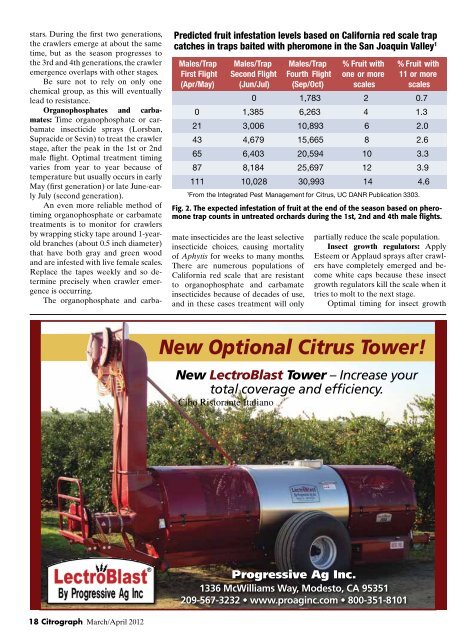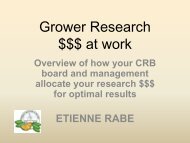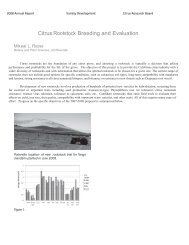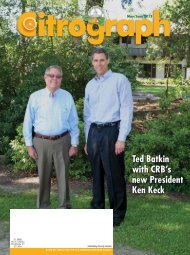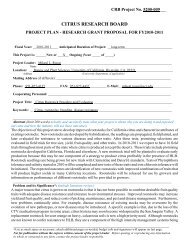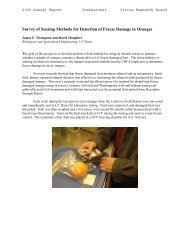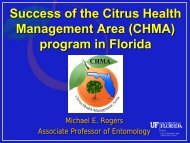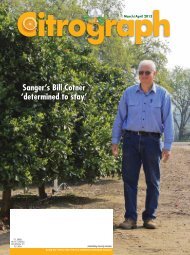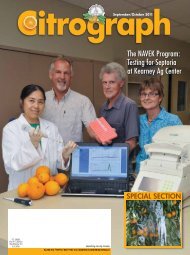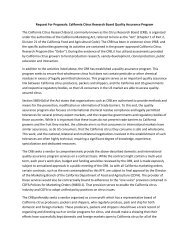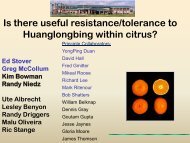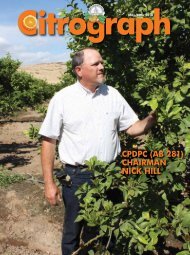IPM practitioner Joe Barcinas with IPM researcher Joseph Morse
IPM practitioner Joe Barcinas with IPM researcher Joseph Morse
IPM practitioner Joe Barcinas with IPM researcher Joseph Morse
Create successful ePaper yourself
Turn your PDF publications into a flip-book with our unique Google optimized e-Paper software.
Predicted Predicted fruit fruit infestation levels based on on California red red scale scale trap trap<br />
catches catches in in traps baited <strong>with</strong> pheromone in in the the San San Joaquin Joaquin Valley Valley 1 1<br />
Males/Trap<br />
First Flight<br />
(Apr/May)<br />
Males/Trap<br />
Second Flight<br />
(Jun/Jul)<br />
Males/Trap<br />
Fourth Flight<br />
(Sep/Oct)<br />
% Fruit <strong>with</strong><br />
one or more<br />
scales<br />
% Fruit <strong>with</strong><br />
11 or more<br />
scales<br />
0 1,783 2 0.7<br />
0 1,385 6,263 4 1.3<br />
21 3,006 10,893 6 2.0<br />
43 4,679 15,665 8 2.6<br />
65 6,403 20,594 10 3.3<br />
87 8,184 25,697 12 3.9<br />
111 10,028 30,993 14 4.6<br />
1<br />
From the Integrated Pest Management for Citrus, UC DANR Publication 3303.<br />
Fig. 2. The expected infestation of fruit at the end of the season based on pheromone<br />
trap counts in untreated orchards during the 1st, 2nd and 4th male flights.<br />
stars. During the first two generations,<br />
the crawlers emerge at about the same<br />
time, but as the season progresses to<br />
the 3rd and 4th generations, the crawler<br />
emergence overlaps <strong>with</strong> other stages.<br />
Be sure not to rely on only one<br />
chemical group, as this will eventually<br />
lead to resistance.<br />
Organophosphates and carbamates:<br />
Time organophosphate or carbamate<br />
insecticide sprays (Lorsban,<br />
Supracide or Sevin) to treat the crawler<br />
stage, after the peak in the 1st or 2nd<br />
male flight. Optimal treatment timing<br />
varies from year to year because of<br />
temperature but usually occurs in early<br />
May (first generation) or late June-early<br />
July (second generation).<br />
An even more reliable method of<br />
timing organophosphate or carbamate<br />
treatments is to monitor for crawlers<br />
by wrapping sticky tape around 1-yearold<br />
branches (about 0.5 inch diameter)<br />
that have both gray and green wood<br />
and are infested <strong>with</strong> live female scales.<br />
Replace the tapes weekly and so determine<br />
precisely when crawler emergence<br />
is occurring.<br />
The organophosphate and carbamate<br />
insecticides are the least selective<br />
insecticide choices, causing mortality<br />
of Aphytis for weeks to many months.<br />
There are numerous populations of<br />
California red scale that are resistant<br />
to organophosphate and carbamate<br />
insecticides because of decades of use,<br />
and in these cases treatment will only<br />
partially reduce the scale population.<br />
Insect growth regulators: Apply<br />
Esteem or Applaud sprays after crawlers<br />
have completely emerged and become<br />
white caps because these insect<br />
growth regulators kill the scale when it<br />
tries to molt to the next stage.<br />
Optimal timing for insect growth<br />
New Optional Citrus Tower!<br />
New LectroBlast Tower – Increase your<br />
total coverage and efficiency.<br />
Cibo Ristorante Italiano<br />
Progressive Ag Inc.<br />
1336 McWilliams Way, Modesto, CA 95351<br />
209-567-3232 • www.proaginc.com • 800-351-8101<br />
18 Citrograph March/April 2012


